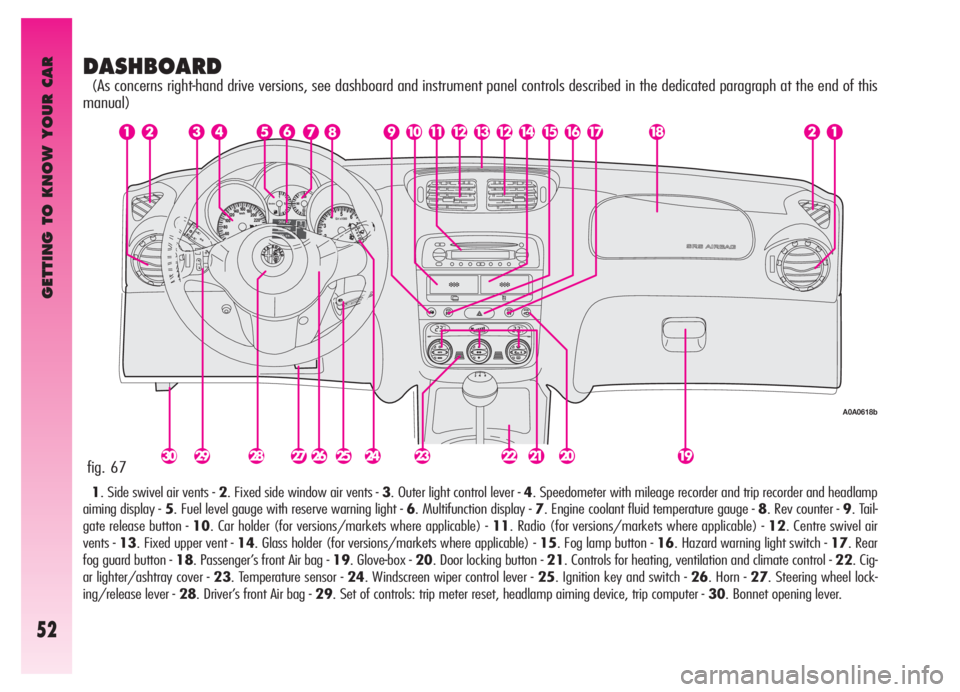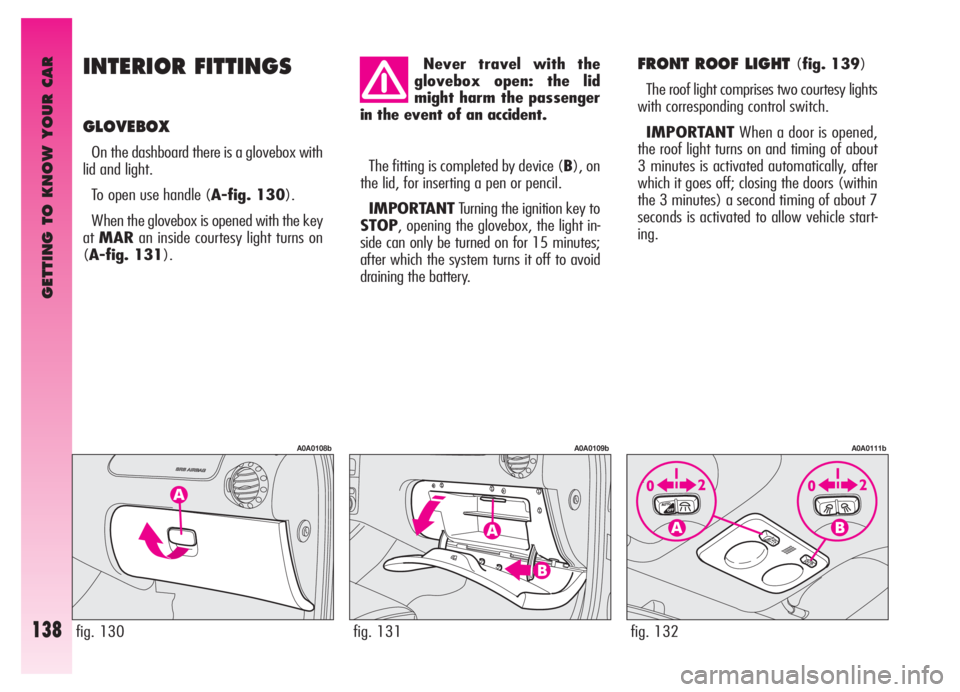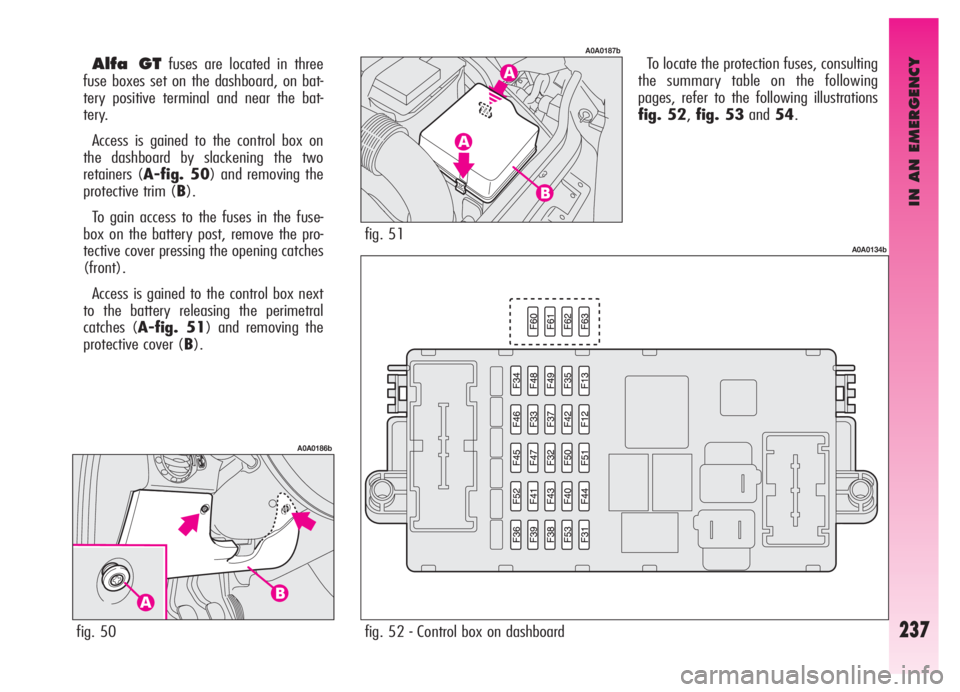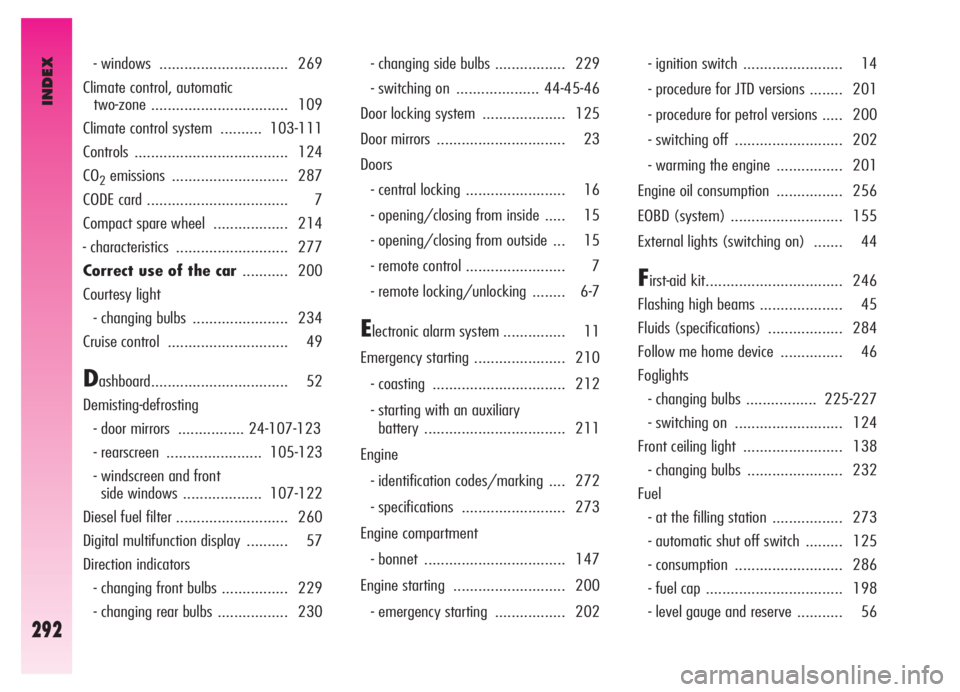dashboard Alfa Romeo GT 2005 Owner handbook (in English)
[x] Cancel search | Manufacturer: ALFA ROMEO, Model Year: 2005, Model line: GT, Model: Alfa Romeo GT 2005Pages: 307, PDF Size: 6.05 MB
Page 54 of 307

GETTING TO KNOW YOUR CAR
52
DASHBOARD
(As concerns right-hand drive versions, see dashboard and instrument panel controls described in the dedicated paragraph at the end of this
manual)
1. Side swivel air vents - 2. Fixed side window air vents - 3. Outer light control lever - 4. Speedometer with mileage recorder and trip recorder and headlamp
aiming display - 5. Fuel level gauge with reserve warning light - 6. Multifunction display - 7. Engine coolant fluid temperature gauge - 8. Rev counter - 9. Tail-
gate release button - 10. Car holder (for versions/markets where applicable) - 11. Radio (for versions/markets where applicable) - 12. Centre swivel air
vents - 13. Fixed upper vent - 14. Glass holder (for versions/markets where applicable) - 15. Fog lamp button - 16. Hazard warning light switch - 17. Rear
fog guard button - 18. Passenger’s front Air bag - 19. Glove-box - 20. Door locking button - 21. Controls for heating, ventilation and climate control - 22. Cig-
ar lighter/ashtray cover - 23. Temperature sensor - 24. Windscreen wiper control lever - 25. Ignition key and switch - 26. Horn - 27. Steering wheel lock-
ing/release lever - 28. Driver’s front Air bag - 29. Set of controls: trip meter reset, headlamp aiming device, trip computer - 30. Bonnet opening lever.
fig. 67
A0A0618b
Page 119 of 307

GETTING TO KNOW YOUR CAR
117
AIR DISTRIBUTION SELECTION
BUTTONS
(fig. 107)
Pressing one or more buttons (10) it is
possible to manually choose one of the 5
possible air distributions to the passenger
compartment:
REFlow of air to the dashboard centre
and side outlets and rear outlet.E
R
ZESplitting of the air flow between the
vents to the lower part of the pas-
senger compartment (warmest air)
and the dashboard centre and side
outlets and the rear outlet (coolest
air). The air flow distribution is par-
ticularly useful in spring and autumn,
when the sun is shining.
ZAir flow towards the front and rear
lower parts of the passenger com-
partment. Due to the natural tenden-
cy of heat to spread upwards, this
type of distribution allows heating of
the passenger compartment in the
shortest time, also giving a prompt
feeling of warmth to the coldest parts
of the body.
A0A0208b
Q
ZSplitting of the air flow between the
windscreen and side window defrost-
ing/demisting vents and the lower
part the of the vehicle. This type of air
distribution allows satisfactory heat-
ing of the passenger compartment
while preventing misting of the win-
dows.
QAir flow to the windscreen and front
side window vents to demist or de-
frost them.IMPORTANTPressing one of these but-
tons turns on (led on button itself on)
or off (led on button off) the associ-
ated functions if the combination cho-
sen is among the 5 possible ones; if
not it only activates the main function
of the button pressed, without the
possibility of turning off with anoth-
er press (at least in one distribution
the air flow should be spread in the
passenger compartment).
To restore automatic air distribution
control after a manual selection, press
button (13)
AUTO. fig. 107
Page 140 of 307

GETTING TO KNOW YOUR CAR
138
INTERIOR FITTINGS
GLOVEBOX
On the dashboard there is a glovebox with
lid and light.
To open use handle (A-fig. 130).
When the glovebox is opened with the key
atMARan inside courtesy light turns on
(A-fig. 131).
FRONT ROOF LIGHT (fig. 139)
The roof light comprises two courtesy lights
with corresponding control switch.
IMPORTANTWhen a door is opened,
the roof light turns on and timing of about
3 minutes is activated automatically, after
which it goes off; closing the doors (within
the 3 minutes) a second timing of about 7
seconds is activated to allow vehicle start-
ing.
fig. 130
A0A0108b
fig. 131
A0A0109b
Never travel with the
glovebox open: the lid
might harm the passenger
in the event of an accident.
The fitting is completed by device (B), on
the lid, for inserting a pen or pencil.
IMPORTANTTurning the ignition key to
STOP, opening the glovebox, the light in-
side can only be turned on for 15 minutes;
after which the system turns it off to avoid
draining the battery.
fig. 132
A0A0111b
Page 149 of 307

GETTING TO KNOW YOUR CAR
147fig. 149
A0A0707b
Do this only with the car
stationary.
DANGER-SERIOUS IN-
JURY. When carrying out
checks or maintenance op-
erations in the engine compart-
ment, take special care not to bump
the head on the raised bonnet.
If checks are needed in
the engine compartment,
when it is still hot, do not
approach the fan: it might start
working also with the ignition key
removed. Wait for the engine to
cool down.
BONNET
The bonnet opening lever is under the left
end of the dashboard.
To open:
– pull the lever (A-fig. 148) until the
bonnet clicks open.
– press the safety lever (A-fig. 149)
upwards.
– raise the bonnet.
IMPORTANTBonnet raising is aided by
two gas springs. Do not tamper with these
springs and accompany the bonnet while
raising it.
fig. 148
A0A0135b
Do not load the boot
above the permitted max-
imum (see “Technical spec-
ifications”). Also make sure that
the objects contained in the boot
are well secured to prevent them
from being thrown forward, caus-
ing harm to the passengers.
A heavy load that has not
been secured may cause
serious harm to passen-
gers.
If you want to carry re-
serve fuel in a can, follow
legal regulations, only us-
ing a certified can, suitably fastened
to the load securing eyelets. Even
in this way the risk of fire is in-
creased in the case of an accident.
Page 158 of 307

GETTING TO KNOW YOUR CAR
156
IMPORTANTAfter eliminating the in-
convenience, to check the system com-
pletely, Alfa Romeo Authorised Services are
obliged to run a bench test and, if necessary,
road tests which may also call for a long jour-
ney.
INTRODUCTION
The radio is fitted with CD player (radio
with Compact Disc player) or CD MP3 play-
er (radio with Compact Disc MP3 player)
and has been designed in accordance with
the specific features of the passenger com-
partment, with a personalised design that
blends with the style of the dashboard. The
radio dimensions are suitable for the car and
as it is of fixed type it cannot be installed on
any other vehicle.
The instructions for use also include how
to control the CD Changer (if fitted) through
the radio. For the instructions for use of the
CD Changer, refer to the specific manual.
ADVICE
Too high a volume when
driving can put the drivers
life at risk and that of oth-
er people. Therefore the volume
should always be adjusted in such
a way that it is always possible to
hear the noises of the surrounding
environment (e.g. horns, ambu-
lance, police sirens, etc.).
Road safety
You are advised to learn how to use the
various radio functions (e.g. storing stations)
before starting to drive.
Reception conditions
The reception conditions change constant-
ly when travelling. Reception may be dis-
turbed by the presence of mountains, build-
ings or bridges in particular if far away from
the broadcasting transmitter. If, turning the ignition key
to MAR, the warning light
Udoes not turn on or if,
while travelling it turns on glow-
ing steadily or flashing (on some
versions together with the mes-
sage + symbol on the reconfig-
urable multifunction display), con-
tact Alfa Romeo Authorised Ser-
vices as soon as possible.
RADIO WITH COMPACT DISC PLAYER
(Upon request for versions/markets where applicable)
Page 239 of 307

IN AN EMERGENCY
237
To locate the protection fuses, consulting
the summary table on the following
pages, refer to the following illustrations
fig. 52,fig. 53and54.Alfa GTfuses are located in three
fuse boxes set on the dashboard, on bat-
tery positive terminal and near the bat-
tery.
Access is gained to the control box on
the dashboard by slackening the two
retainers (A-fig. 50) and removing the
protective trim (B).
To gain access to the fuses in the fuse-
box on the battery post, remove the pro-
tective cover pressing the opening catches
(front).
Access is gained to the control box next
to the battery releasing the perimetral
catches (A-fig. 51) and removing the
protective cover (B).
fig. 50
A0A0186b
fig. 51
A0A0187b
fig. 52 - Control box on dashboard
A0A0134b
Page 243 of 307

IN AN EMERGENCY
241
Volumetric sensors
ESP system sensor
Steering angle sensor
EOBD system diagnosis socket
Cell phone provision
Driver’s door control unit supply
Passenger’s door control unit supply
Control lighting
Climate control system control lighting
Instrument cluster
Instrument cluster
Driver’s door control unit
ABS control unit
ABS control unit
Dashboard control unit
Air - bag control unit
Electronic injection control unit +30
Engine compartment control box (petrol versions)
Dashboard control unit
Trailer control unit15
7.5
7.5
15
15
20
20
7.5
7.5
10
10
15
7.5
50
50
7.5
7.5
125
70
10 F39
F42
F42
F39
F39
F47
F48
F49
F35
F37
F53
F39
F42
F04 (MAXI-FUSE)
F02 (MAXI-FUSE)
F50
F18
F70 (MEGA-FUSE)
F71 (MAXI-FUSE)
F36 52
52
52
52
52
52
52
52
52
52
52
52
52
53
53
52
53
54
54
52
SERVICES FIGURE FUSE AMPERES
Page 244 of 307

IN AN EMERGENCY
242
40
30
50
15
15
15
15
25
7,5
15
15
30
30
50
20
150
40
60
20 F05 (MAXI-FUSE)
F06 (MAXI-FUSE)
F07 (MAXI-FUSE)
F10
F21
F22
F21
F60 (*)
F16
F61 (*)
F62 (*)
F08
F72 (MAXI-FUSE)
F01 (MAXI-FUSE)
F20
F70 (MEGA-FUSE)
F06 (MAXI-FUSE)
F07 (MAXI-FUSE)
F22 53
53
53
53
53
53
53
52
53
52
52
53
54
53
53
54
53
53
53
SERVICES FIGURE FUSE AMPERES
(*) Fuse behind dashboard control box on an auxiliary bracket.
Climate control fan
Radiator fan (first speed - petrol versions)
Radiator fan (second speed - petrol versions)
Horn
Fuel pump
Injectors (petrol versions)
Ignition coils
Tailgate electric unlocking
Electronic injection system
Bose system
Bose system
Additional heater
Ignition switch
Glow plug warming (JTD versions)
Heated fuel oil filter (JTD versions)
Engine compartment control box (JTD versions)
Radiator fan (first speed – JTD versions)
Radiator fan (second speed – JTD versions)
Injectors (JTD versions)
Page 290 of 307

RIGHT HAND DRIVE VERSIONS
288
fig. 6
A0A0724b
RIGHT HAND DRIVE VERSIONS - DASHBOARD
1.Side swivel air vents - 2.Fixed side window air vents -3.Passenger's air bag - 4.Tailgate release button - 5.Card holder (for versions/markets where
applicable) - 6. Sound system (for versions/markets where applicable) - 7.Centre swivel air vents - 8.Fixed upper vent - 9.Glass holder (for versions/mar-
kets where applicable) - 10.Front fog light button - 11.Hazard light switch - 12.Rear fog light button - 13.Outside light control lever - 14.Speedome-
ter with display for mileage recorder, trip meter and headlamp aiming device - 15.Fuel level gauge with reserve warning light - 16.Multifunction display -
17.Engine coolant temperature gauge - 18.Rev. counter -19.Windscreen wiper control lever - 20.Bonnet opening lever - 21.Set of controls: trip meter
reset, headlamp aiming device, trip computer - 22.Ignition key and switch - 23.Horn - 24.Steering wheel locking/release lever - 25.Driver's air bag -
26.Door locking button - 27.Controls for heating, ventilation and climate control - 28.Cigar lighter/ashtray housing door - 29.Temperature sensor - 30.
Glove box.
Page 294 of 307

INDEX
292
- windows ............................... 269
Climate control, automatic
two-zone ................................. 109
Climate control system .......... 103-111
Controls ..................................... 124
CO
2emissions ............................ 287
CODE card .................................. 7
Compact spare wheel .................. 214
- characteristics ........................... 277
Correct use of the car........... 200
Courtesy light
- changing bulbs ....................... 234
Cruise control ............................. 49
Dashboard................................. 52
Demisting-defrosting
- door mirrors ................ 24-107-123
- rearscreen ....................... 105-123
- windscreen and front
side windows ................... 107-122
Diesel fuel filter ........................... 260
Digital multifunction display .......... 57
Direction indicators
- changing front bulbs ................ 229
- changing rear bulbs ................. 230- changing side bulbs ................. 229
- switching on .................... 44-45-46
Door locking system .................... 125
Door mirrors ............................... 23
Doors
- central locking ........................ 16
- opening/closing from inside ..... 15
- opening/closing from outside ... 15
- remote control ........................ 7
- remote locking/unlocking ........ 6-7
Electronic alarm system ............... 11
Emergency starting ...................... 210
- coasting ................................ 212
- starting with an auxiliary
battery .................................. 211
Engine
- identification codes/marking .... 272
- specifications ......................... 273
Engine compartment
- bonnet .................................. 147
Engine starting ........................... 200
- emergency starting ................. 202- ignition switch ........................ 14
- procedure for JTD versions ........ 201
- procedure for petrol versions ..... 200
- switching off .......................... 202
- warming the engine ................ 201
Engine oil consumption ................ 256
EOBD (system) ........................... 155
External lights (switching on) ....... 44
First-aid kit................................. 246
Flashing high beams .................... 45
Fluids (specifications) .................. 284
Follow me home device ............... 46
Foglights
- changing bulbs ................. 225-227
- switching on .......................... 124
Front ceiling light ........................ 138
- changing bulbs ....................... 232
Fuel
- at the filling station ................. 273
- automatic shut off switch ......... 125
- consumption .......................... 286
- fuel cap ................................. 198
- level gauge and reserve ........... 56